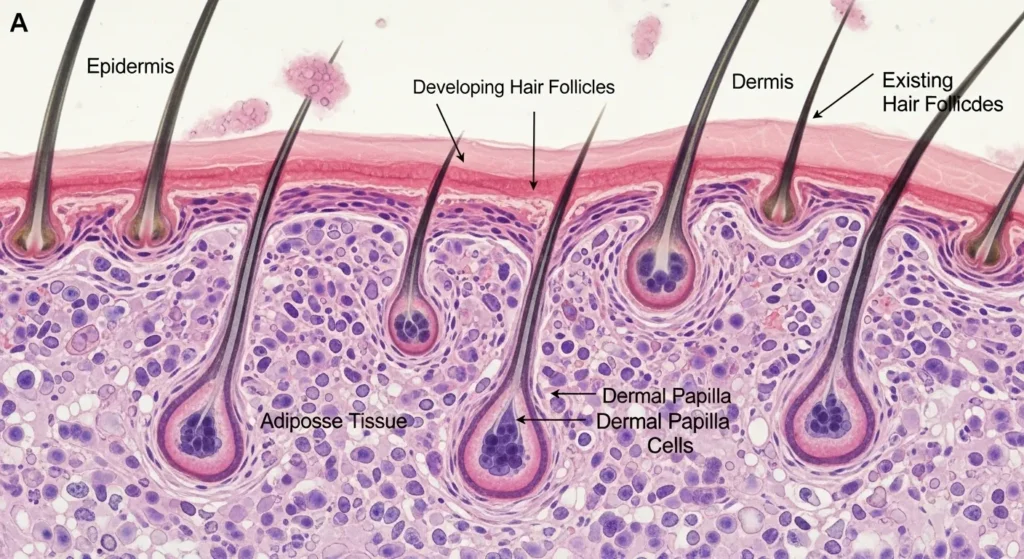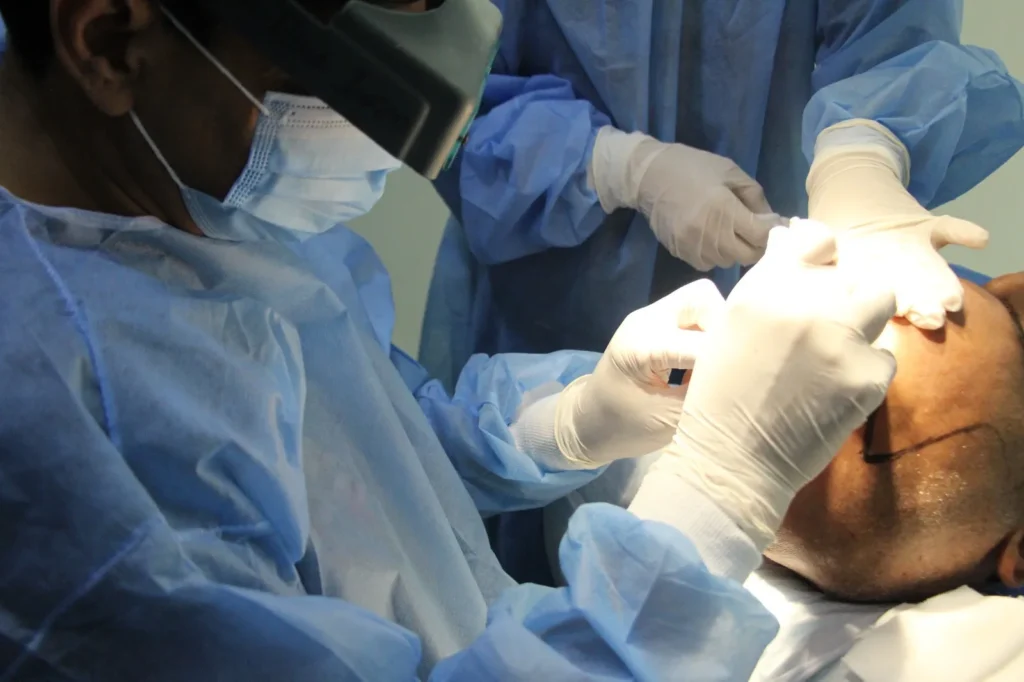Are you frustrated by thinning hair and wondering if Hair Follicular Neogenesis Hair Losstreatments really work? This advanced hair restoration approach focuses on generating entirely new hair follicles, not just reactivating dormant ones.
In this blog, you’ll learn how follicular neogenesis works, why it’s different from traditional methods, and what results you can expect. From expert insights to real-world examples, we’ll guide you through this promising innovation in hair loss treatment and help you make an informed, confident decision.
What Is Follicular Neogenesis Hair Loss?

Definition & How It Differs from Typical Hair Loss
Follicular neogenesis refers to the formation of new hair follicles from scratch, rather than reviving existing but miniaturized ones. Most hair loss treatments — like minoxidil or finasteride — aim to preserve or reactivate follicles. In contrast, neogenesis seeks to create brand-new follicles, a concept derived from regenerative medicine and stem cell science.
This is particularly significant for patients who have lost a large number of follicles and for whom traditional methods offer limited benefits.
The Science Behind New Follicle Creation
In mammals like mice, scientists have observed a natural process called Wound-Induced Hair Neogenesis (WIHN), where hair regrows in injured skin through cellular reprogramming. Researchers are now working on replicating this process in humans using microneedling, bioactive compounds, and stem-cell technologies.
Why Traditional Treatments Aren’t Enough
Limitations of Minoxidil, Finasteride, PRP & LLLT
While widely used, most conventional hair loss treatments have limitations:
- Minoxidil: Increases blood flow but doesn’t create new follicles.
- Finasteride: Prevents further loss by blocking DHT, but may not regrow significant hair.
- PRP: Enhances follicular activity but requires existing follicles.
- LLLT: Low-level laser therapy improves density but works slowly and only if follicles are alive.
None of these addresses severe balding or follicle-depleted scalps.
Gaps That Neogenesis Can Fill
Follicular neogenesis fills the gap by aiming to:
- Create entirely new follicles
- Restore hair in completely bald areas
- Offer hope for those with scarring alopecia or advanced pattern baldness
How Follicular Neogenesis Works
Hair Follicle Anatomy & Signaling Pathways
Hair follicles form through complex biological signals during embryogenesis. Researchers are now trying to reactivate these pathways in adults, especially:
- Wnt/β‑catenin signaling – crucial for follicle regeneration
- FGF (Fibroblast Growth Factor) and IGF‑1 (Insulin-like Growth Factor) – support follicle formation and growth
- Sonic Hedgehog Pathway – aids in follicular differentiation
Inducing Neogenesis: Wounding, Devices, and Serums
One promising method is controlled wounding via microneedling, which stimulates a healing response that includes:
- Follica Device – Combines microneedling with topical stimulants (e.g., minoxidil or custom serums)
- Scalp abrasion techniques – Promote dermal remodeling and cell signaling
- Serums with peptides or growth factors – Enhance cellular regeneration
Emerging Molecular Treatments
Innovative compounds such as PTD-DBM (a topical protein delivery molecule) are showing promise in inducing neogenesis in lab models. In animal studies, PTD-DBM has successfully activated Wnt pathways and initiated new follicle formation within 4–6 weeks.
Real Results & Case Studies
Follica Device Data: Trial Outcomes
Clinical studies on the Follica hair regeneration system showed:
- 13+ new follicles per cm² after 3 months
- Enhanced response in combination with topical minoxidil
- Stronger results in younger patients (<45) with early-stage baldness
Mouse Model Breakthroughs
Mice with full-thickness skin wounds have regrown hair with characteristics similar to natural follicles. While humans lack this innate ability, similar cellular pathways are now being triggered using engineered scaffolds and microneedling.
Clinics Offering Treatments in Pakistan
At clinics like Vagus Hair Transplant Islamabad, follicular neogenesis approaches are being explored through:
- Microneedling + growth serums
- Post-PRP healing modulation
- Low-level laser protocols
Timeline, Safety & Costs
Typical Treatment Schedule
Most patients undergo:
- Weekly microneedling for 4–6 weeks
- Topical application of growth factors immediately after
- Visible changes in 3–4 months, with best results after 6–12 months
Potential Side Effects & Safety Profile
Side effects are generally mild:
- Redness or irritation (temporary)
- Slight discomfort post-needling
- Rare: infection if hygiene isn’t maintained
Treatments should always be performed by qualified professionals in sterile environments.
Cost Estimates in Pakistan
Pricing may vary by clinic and protocol:
- Single session: PKR 8,000–15,000
- Full package (4–6 sessions): PKR 40,000–90,000
- Follica or advanced devices: Higher costs depending on technology
Research-Based Recommendations
- Combine neogenesis with minoxidil or PRP for enhanced results
- Patients under 50 respond better
- Avoid if you have active infections or autoimmune scalp conditions
Treatment Comparison Chart
| Treatment | Creates New Follicles | Regrows Existing Hair | Invasive | Timeline |
|---|---|---|---|---|
| Neogenesis | ✅ | ✅ | ❌ | 4–12 months |
| Transplant | ✅ | ❌ | ✅ | 6–9 months |
| Minoxidil | ❌ | ✅ | ❌ | 3–6 months |

Comparing Your Options
Neogenesis vs Hair Transplant vs Combination Therapies
| Feature | Neogenesis | Hair Transplant | Combination |
|---|---|---|---|
| Suitable for bald zones | ✅ | ✅ | ✅ |
| Downtime | Minimal | Moderate | Minimal–Moderate |
| Results timeline | 3–12 months | 6–12 months | 3–12 months |
| Cost | Medium | High | Variable |
Pros & Cons Chart
Pros:
- Non-invasive
- Can work in combination with other therapies
- Stimulates natural regrowth
Cons:
- Still under research
- Not effective for everyone
- Multiple sessions needed
How to Prepare & Choose the Right Clinic
Questions to Ask Your Doctor
- Do you use any device-based follicular neogenesis systems?
- Is this FDA-approved or under trial?
- What growth factors or serums do you apply?
- How many sessions will I need?
What to Expect During Consultation
- Scalp examination and diagnosis
- Discussion on expectations
- Timeline, package, and pricing
- Consent and treatment planning
FAQs on Follicular Neogenesis Hair Loss
Is follicular neogenesis safe?
Yes, when performed by certified professionals. Side effects are typically mild.
Who is a candidate for neogenesis?
Ideal for men and women under 50 with early to moderate hair thinning or patchy baldness.
How long until I see results?
Initial signs of regrowth may appear in 3–4 months; full results in 6–12 months.
Can it prevent balding entirely?
No, but it may delay progression and stimulate regrowth if used early.
Are there any risks?
Minor skin irritation, especially with microneedling. Infection risk is low with proper hygiene.
Take Your Next Step
Book a consultation with Dr. Rana Irfan to explore if follicular neogenesis is right for your hair restoration journey. With cutting-edge solutions and medically supervised care, you’re one step closer to natural, fuller hair.
Follicular neogenesis for hair loss represents a major leap forward in hair science, offering a way to regenerate brand-new follicles non-surgically. While still under study, early evidence and clinical use are promising, especially when combined with proven therapies. Talk to an expert today to see if this groundbreaking treatment could work for you.
